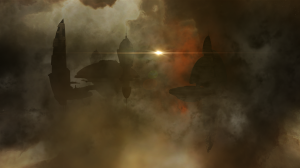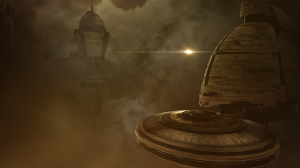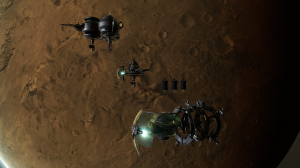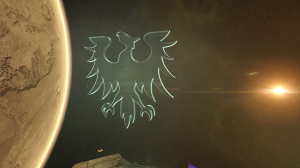Editor’s note: CCP heavily revamped the Traumark Installation in YC123 (that’s 2021 for you non-lore-speakers). This entry chronicles how the site looks after the revamp, but if you’d like to see the original entry as it dates from YC112 (2010!), please click here.
I don’t believe in ghosts, much less space ghosts.
It’s critical that I am clear on this particular point given today’s entry. I don’t. Believe. In space ghosts.
But if I did believe in space ghosts, and if I was forced to pick one location in space where they absolutely, positively, 100 percent lived, I would definitely pick the creepy abandoned fortress surrounded by dark, spooky clouds filled with flashes of blood red lightning and also plenty of Sansha cybernetic zombies. Yeah, that sounds about right.
I don’t believe in space ghosts. And, just to prove it, I repeated it to myself. Over and over and over again as I explored the ruins of Old Traumark, who fit the description above to a T. But it’s fine, it’s not like I was scared or anything, because I don’t believe in space ghosts, you see. Just like I told myself. Repeatedly.
As is appropriate for most sites that definitely are not haunted (they can’t be! Because ghosts aren’t real!), the old Traumark Installation used to be a crown jewel for expansion of the Tash-Murkon royal family. Meant to serve as a bulwark of civilization against the untamed systems of Stain one jump out, Traumark was long thought to be impregnable against anything that Sansha or anyone else from Stain could throw at it. That conceit ended up being… erroneous on the Tash-Murkon Family’s part.
Aura explains a bit further:
The Old Traumark Installation was formerly a massive fortress guarding the southern space territories of the vastly rich Tash-Murkon royal family. At its height it represented the proudest moment in the history of the Tash-Murkon and a symbol of their commitment to progress and development. Yet that proud moment came and went, for the fortress, once thought to be impregnable, fell into the hands of Sansha’s Nation
Over the subsequent years several attempts were made to recapture and renovate the installation, however each attempt was stymied by the entrenched Sansha forces. The close proximity to Stain allowed Nation reinforcements to arrive with little warning, and the stations themselves were riddled with booby traps and infested by numerous cybernetically-augmented True Slave soldiers.
After these failed attempts to recapture the ruins, the pragmatic Tash-Murkons eventually changed their approach and chose to build a new Traumark Installation at a nearby location. Now two versions of the great southern fortress exist just a short warp away from each other: a bright shining facility that represents the best of Amarr progress and might, and the ruined fortification that serves as an ever-present reminder of that might’s limits.
Old Traumark consisted of 3 stations of familiar Amarr design. The Sansha have maintained the superstructures of those stations (surprisingly, the stations don’t have so much a single added spike to their design), but beyond the familiar shapes you might never guess that the Amarr ever controlled the station. Sansha ships constantly patrol the space between and around the stations. Pervading the entire area are dark clouds that nearly blot out distant Saminer. I can’t quite tell where the clouds came from. Perhaps its just debris that the Sansha have simply kicked into space as they maintained the stations over the years. Perhaps a particularly thick dust cloud moved into the area. Perhaps it’s simply the malevolent intent of the Sansha and their dark goals made manifest.
One thing I can definitely guarantee that the dark clouds are not: a ghostly miasma. Because, as I feel the need to remind myself consistently, ghosts aren’t real.
Either way, as I watch the scene, I find myself needing to reiterate that refrain even more. For between the stations, and between particularly dense patches of the dark and spooky clouds, lightning can be seen flickering within the depths. Lightning in space is a relatively rare occurrence, but not uncommon. What is uncommon, however, about this particular brand of space lightning is the color: a dark, blood red. If I hadn’t known that the Sansha were the ones that controlled the area, I would have expected Blood Raiders in the area given the overall motif.
I admittedly did not spend a lot of time looking over the scene. Not because I was afraid of ghosts or anything of the sort (I’m a sensible, rational individual and the concept is patently ridiculous, you see), but because afraid of one of the roaming Sansha patrols accidentally decloaking me in my unarmed Professor Science. And also because I wasn’t sure of the effect of getting hit by the blood red lightning. And also because I was really, truly interested in examining the modern fortress installation that could be found nearby. And so I after I got a sense of the site and snapped a few images from my camera drones, I set course away from the Ruins of Old Traumark.
And away from the ghosts that definitely don’t exist.
Basic Information:
- Attraction: The Ruins of Old Traumark
- System: Saminer
- Security Rating: 0.3
- Region: Tash-Murkon
- Potential Hazards: Saminer is located in low security space. Pirates and gate camps should be expected, and caution is advised. A cov ops or other cloaking ship is recommended. There definitely aren’t any ghosts around, at least, because there’s no such thing as ghosts.















































